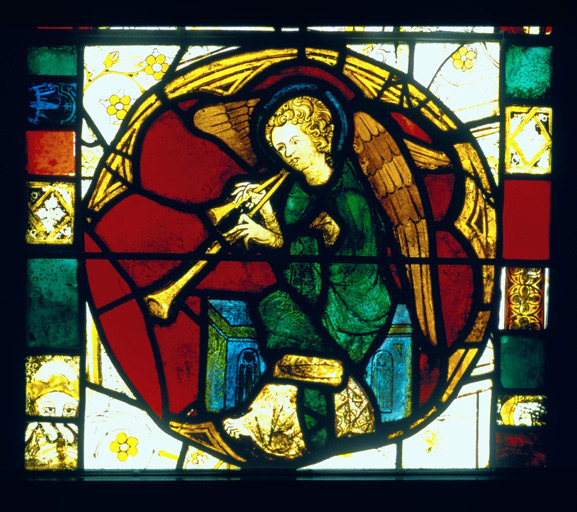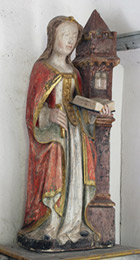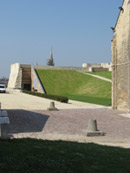Normandy during the last centuries of the Middle Ages was a land of contrasts. Having inherited a glorious past from the time duke William became the Conqueror of England (1066), it has a strong imprint of an Anglo-Norman identity expressed in the dozens of Roman churches still visible today. Normandy is the product of an original culture, the synthesis of migratory currents from North-Western Europe.
A white coat of churches
In 1204, it had to abandon its independence to enter the Capetian kingdom. This French Normandy was first blessed by a long century of peace and economic prosperity and then projected into the 100 Year War. It kept though, under all circumstances, a rich artistic production. Churches, abbeys and in particular cathedrals were permanent construction sites where former buildings were permanently transformed, restored, embellished and sometimes reconstructed. Slowly but surely decoration took on a new form throughout the XIIIth century. Statues with encrusted enameling, rather clumsy in the beginning, became increasingly refined and with time became the rule. The uncontainable profusion of sculpted works then happily invaded the interior space of religious buildings. Various groups are shown here, in particular the later and more refined figures, linked to the iconography of the Passion of Christ. Stained glass windows also experienced an unprecedented development as of the XIIIth century and largely contributed to the decoration of churches, as can be seen with the eight musician angels from Dives-sur-Mer.
Under the Virgin's aegis
The affirmation of the cult of the Virgin Mary, which reached its climax in the XIVth century, is the very quintessence of this gothic art. All the churches had one of the countless representations of Mary. Modest or sumptuous, sitting or with a long open coat, nursing the child or carrying him on her arm … the Virgin Mary was everywhere and quickly became the carrier of artistic production. The exhibition presents a rich selection, from the Sitting Virgin from Martinvast to the Standing Virgin with Child from Octeville, a prototype that was reproduced one thousand times. This parade of stone Virgins was interrupted by an authentic masterpiece, the Marie-Madeleine from Ecouis. Voluptuously wrapped in her hair alone, it is the most unexpected Gothic statue one can see but also the most ancient representation of Marie-Madeleine.
From sculpture to gold and silver work
The powerful clergy of Western Normandy commissioned local artists who were undoubtedly less gifted but rich with an unexpected iconographic repertoire (Education of the Virgin, Presentation to the Temple, Ecce Homo…). Regional saints as well as the «major» saints from the Gospel were also the objects of an ever-surprising production, given its diversity and its constant evolution in style. We can admire in particular the nine apostles from Saint Peter's apostolic College in Jumièges, in a piercing and elegant style, which miraculously survived the destructions of the XIXth century. The silver and gold work which framed the relics and sumptuously rivaled them has rarely been seen in our time, given precisely the uniqueness of the material. Yet, as History has its ways, Normandy holds the only two large French Gothic reliquaries, the ones from the church of the abbey of Saint-Taurin in Evreux and that of Saint-Romain in the cathedral of Rouen. They will be presented here together, for the first time.
PUBLICATIONS:
Catalogue of the exhibition, 200 p., 130 ill, 35 €
Journal of the exhibition, 20 p., colored illustrations, 3 €
llustration: Sainte Barbe, circa 1500, Sainte-Marie-Outre-L’Eau (Calvados), photo : P. Corbierre © Inventaire général du Patrimoine culturel de Basse-Normandie
New spaces for the museum
The first phase of restoration works of the castle initiated by the city of Caen has allowed the museum to increase its surface by more than 1200 sq.meters of floor space over three levels. The exhibition will inaugurate a large 200 sq meter exhibition area, the Salles du Rempart -The Rampart Rooms. A pedagogic reception space will also be included at the junction of the exhibition rooms and that of the Exchequer of the Dukes of Normandy. In the basement a study and conservation gallery allows the museum to display its collections between the currently overcharged reserves and the new premises. The museum offers, for the opening of the Rampart Rooms, an archeological itinerary of a forge, of a XIVth century house and of an enigmatic underground passage discovered during the works. Visitors will enjoy unusual views of the duke's palace and the large dungeon from a belvedere all may access through an elevator hidden in a medieval tower.
The Rampart , general view
To see more illustrations, click on VERSION FRANCAISE at the top of this page
| 









